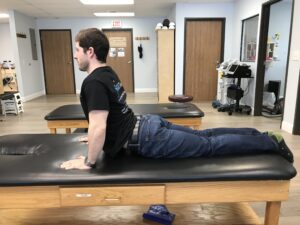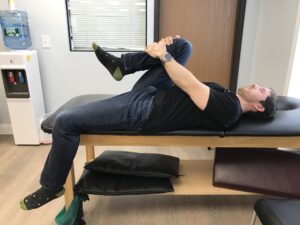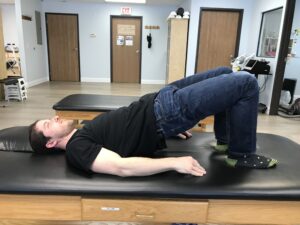
I Screen, You Screen, We All Screen, for Back and Neck Pain!
A recent study from the Harvard School of Public Health, Brigham and Women’s Hospital, and Microsoft showed that holding a tablet too low in your lap can place the small, interlocking bones at the top of the spine (the cervical vertebrae) and the neck muscles into an unnatural posture. This, along with sitting in front of a computer screen all day, is harmful to our mid and lower back. These repeated and prolonged positions day in and day out can strain muscles, nerves, tendons, ligaments, and spinal discs.
How can you limit the damage? The first step is simply to become aware of your posture and what you are doing every day. If you spend a lot of time on a handheld phone or using a desktop computer, laptop, or tablet, pause occasionally to notice how your body is situated. Is your back curved? Shoulders hunched? Head bent downward? Chin jutting forward or head slumped toward one shoulder? Are your legs crossed, hiking one hip higher than the other? Back pain is one of the most common reasons for missed work.
Good ergonomics and regular posture checks can help to correct these problems.
Ergonomics for computers, phones, and tablets
If you use a laptop or desktop computer:
- Choose a chair with good lumbar support, or place a pillow against the small of your back.
- Position the top of your monitor just below eye level and an arm’s length away. That helps whether you use a desktop or a laptop.
- Sit up straight with your head level, not bent forward. Craning your neck can put up to 60lbs of added pressure on your cervical spine
- Be aware of how many times you look down to check your cell phone. Consider using a computer-based texting app, instead.
- Keep your shoulders relaxed and your elbows close to your body. Keep hands, wrists, forearms, and thighs parallel to the floor
- If you use a mouse, keep it close to you
- Are the contents of your desk within reach? Even if your monitor is at the correct height, if your documents or other important tools are at the wrong height, you may still be constantly moving your body back into the poor posture throughout the workday.
Get a headset if on the phone a lot.
If you use an e-reader, tablet, or cell phone:
Try to hold the device up so you are not looking down all the time
- Buy a case that allows you to prop the device at a comfortable viewing angle,
- Take a break every 15 minutes. “Just change your hands, shift your weight. Stand up or sit down,”
- Get up at least once an hour. Use smartphone apps and desktop reminders to alert you.
- Maintain good posture away from the screen when you’re standing or sitting.
With time and repeated correction, you can minimize work-related back pain and eliminate many of its causes. If you are currently having neck, back or shoulder pain click here or call 973-400-3730 to schedule an evaluation to assess your work and screen habits so you can start addressing the cause of your pain, and feeling pain-free.
Here are 5 simple exercises you can start right away. Hold all stretches for 20 seconds and repeat 3-4 times on each side.
Doorway Stretch
Stand in the doorway, elbows at 90 degrees on the door frame. Step forward and feel a stretch in the front of your chest, keeping your eyes looking straight ahead.
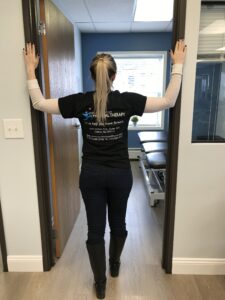
Piriformis Stretch
Sitting on the edge of the chair, cross ankle over the opposite knee and then gently lean forward.
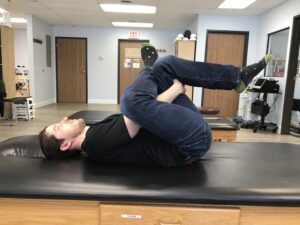
Extension in Lying
Lying on the bed or the floor, hands by your shoulders, gently push up through the arms and arch the thoracic and lumbar spine into extension.
Hip Flexor Stretch
Lying on the edge of the bed or couch, bend both knees up. Then let one leg hang off the edge to feel a stretch in the front of the hip.
Glute Bridges
Lying down, gently squeeze the buttocks and lift the butt off the bed/floor and hold 2 seconds. Then lower down. Do as many as you can, then rest and repeat. Gradually increase the number you do overtime.
Cervical Retraction with Extension
Sitting in a chair with good posture, use your neck muscles to glide your head back. When you cannot go any further, lookup, making sure your head stays back, and perform a little side-to-side wiggle of your head. While keeping your head gliding back, return your head looking forward and relax. Repeat 20x.
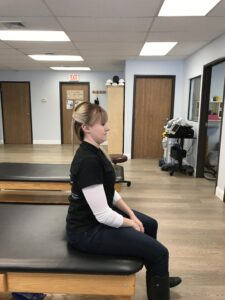
Cervical retraction
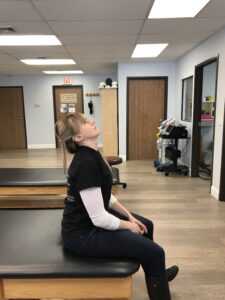
Cervical Extension
